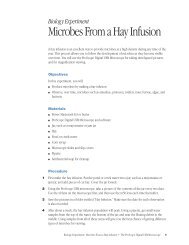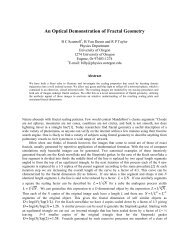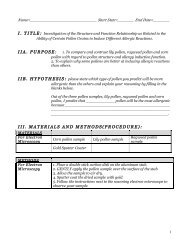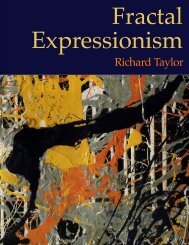December 2004 - Materials Science Institute - University of Oregon
December 2004 - Materials Science Institute - University of Oregon
December 2004 - Materials Science Institute - University of Oregon
You also want an ePaper? Increase the reach of your titles
YUMPU automatically turns print PDFs into web optimized ePapers that Google loves.
CARGILL (top); VALEO (middle); OPTOBIONICS CORPORATION (bottom)<br />
AGRICULTURE<br />
MetaMorphix<br />
Savage, Md.<br />
Identified the best mates for cattle breeding by using genomic information.<br />
Genetic engineering <strong>of</strong> animals still elicits shrill reactions from many consumers.<br />
But MetaMorphix has sought to bypass this controversy by using genetics to<br />
identify the ordinary cattle that produce the best meat. Breeding then proceeds the<br />
traditional way. Having acquired the livestock genotyping business from Celera,<br />
a company that sequenced the human genome, MetaMorphix created a test that<br />
examines DNA to identify differences between animals. Since 2002 Cargill, the<br />
partner <strong>of</strong> MetaMorphix, has tested 4,000 cattle to determine which genetic markers<br />
are associated with traits such as the marbling and tenderness <strong>of</strong> meat and the<br />
animals’ growth rate. A prototype for a commercial test kit is being prepared, and<br />
the fi rst meat produced using this genetic analysis is expected to arrive at grocery<br />
stores by next summer. Monsanto recently struck a similar arrangement with Meta-<br />
Morphix to improve the quality <strong>of</strong> pork.<br />
Smart safety system<br />
warns drowsy drivers to<br />
stay between the lines.<br />
BIOMEDICAL ENGINEERING<br />
Optobionics Corporation<br />
Naperville, Ill.<br />
Thirty million people worldwide are affl icted<br />
with age-related macular degeneration and<br />
retinitis pigmentosa, two potentially debilitating<br />
eye diseases for which there is no cure. By<br />
crippling the retina’s ability to sense and process<br />
light, the conditions can make a patient’s<br />
world go from blurry to black. Clinical trial<br />
results published this past April confi rmed<br />
that a microchip developed by Optobionics<br />
that is implanted under the retina resulted in<br />
signifi cant visual improvement with virtually<br />
no adverse side effects. Designed by brothers<br />
Vincent and Alan Chow, the chip emits<br />
electrochemical impulses to stimulate the<br />
remaining healthy retinal cells. It derives its<br />
power from light entering the eye and reaching<br />
5,000 microphotodiodes, which allows<br />
the chip to function free <strong>of</strong> wires or batteries.<br />
It is thinner than a human hair and can be<br />
implanted during a two-hour operation.<br />
SA 50<br />
(business leaders)<br />
A partner <strong>of</strong> Metamorphix, Cargill has<br />
tested 4,000 cattle for genetic markers.<br />
AUTOMOTIVE<br />
Nissan North America<br />
Gardena, Calif.<br />
Deployed a driver-alert sensor system to keep vehicles safely inside traffic lanes.<br />
Nissan’s luxury division, Infi niti, has adopted for some <strong>of</strong> its models an innovative electronic<br />
system that warns a driver when a car veers out <strong>of</strong> a lane. Studies indicate that 55 percent <strong>of</strong><br />
fatal accidents in the U.S. involve unintentional straying from lane to lane, which is typically<br />
caused by driver distraction, inattention or drowsiness. Developed by engineers at Valeo, a<br />
component supplier based in Auburn Hills, Mich., and Iteris, an Anaheim, Calif., maker <strong>of</strong><br />
auto sensors, the new traffi c-lane monitoring device alerts a driver when a vehicle wanders<br />
outside lane boundaries, a condition that is detected when he or she fails to engage the direction<br />
indicators. The motorist can then take corrective action in a timely fashion. The driver’s<br />
aid uses a miniature video camera backed by s<strong>of</strong>tware that recognizes lane markings. It will<br />
be <strong>of</strong>fered this fall in North America on Infi niti’s 2005 FX crossover sport utility vehicle.<br />
Developed a retinal implant microchip to treat macular degeneration.<br />
A retinal implant chip could<br />
restore vision to macular<br />
degeneration patients.<br />
www.sciam.com SCIENTIFIC AMERICAN 53<br />
COPYRIGHT <strong>2004</strong> SCIENTIFIC AMERICAN, INC.















